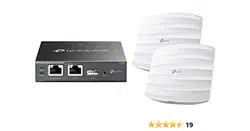
Thank you for purchasing Omada Hardware Controller. This
Installation Guide is designed to guide you through installation.
Note: The image may dier from the actual product.
Package Contents
1
1000M (For OC300)
On: Running at 1000 Mbps.
O: Running at 10/100 Mbps.
Link/Act
On: A device is linked to the corresponding port but no activity.
Flashing: Transmitting or receiving data.
O: No device is linked to the corresponding port.
Ethernet Ports (For OC300) and ETH2 Port (For OC200)
Connected to a device to transmit data.
ETH1 (PoE IN) Port (For OC200)
Connected to a standard 802.3af/at PoE device, such as a
TP-Link PoE switch, to transmit data and gain power supply
simultaneously.
USB 2.0/3.0 Port
Connected to a storage device to back up the conguration le
and database. For OC200, this port is available only when OC200
is powered by a PoE device.
Reset Button
After the device is initialized, press and hold the button for 5s to
reset the device to its factory default settings.
Cloud LED
On: The device is bound to a TP-Link ID.
Slow Flashing: The device is connected to cloud but not bound
to a TP-Link ID.
Quick Flashing: The device is being reset to its factory default
settings.
O: The device is disconnected from cloud.
Power LED
On: Working normally.
O: Working abnormally.
Omada Hardware Controller
ETH1 (PoE IN) ETH2 USB 2.0 Port Reset
Cloud LED
Power LED
Front Panel of OC300
Front Panel of OC200
Cloud LED
Reset Power LED USB 3.0 Port
Rear Panel of OC200
Rear Panel of OC300
Kensington Security Slot Power Socket
Micro USBKensington Security Slot
Ethernet Ports
Hardware Overview
2
Desktop Installation
1. Set the device on a at surface to support the entire weight of
the device with all ttings.
2. Remove the adhesive backing papers from the rubber feet.
3. Turnover the device and attach the supplied rubber feet to the
recessed areas on the bottom at each corner of the device.
Rack Installation (Only for OC300)
1. Check the grounding and stability of the rack.
2. Secure the supplied rack-mounting brackets to each side of
the device with supplied screws.
3. After the brackets are attached to the device, use suitable
screws (not provided) to secure the brackets to the rack.
Installation
3
Connect an Ethernet cable from the ETH1 (PoE IN) port of
OC200 to a standard 802.3af/at PoE device, such as TP-Link
PoE switch. Make sure your power supply matches your
device. The power source should meet PS2 and other
requirements according to IEC 62368-1.
Connect a USB cable (not provided) from the micro USB port
of OC200 to the USB Power Source (5 VDC, minimum 1 A).
The Cloud LED ashes three times when initialization is nished.
For OC200
Kensington Security Slot
Secure the lock (not provided) into the security slot to prevent
the device from being stolen.
Power Socket (For OC300)
Connect the female connector of the power cord here, and the
male connector to the AC power outlet (100-240V~50/60Hz).
Micro USB (For OC200)
Connected to a USB Power Source (5 VDC, minimum 1 A) to
gain power supply if PoE is not available.
Installation Guide
Installation Guide
Omada Hardware Controller
Setup with videos
Scan QR code or visit
https://www.tp-link.com/support/setup-video/
Feet
Mounting Brackets
and Screws
(Only for OC300)
Omada
Hardware Controller
(OC200 for illustration)
Ethernet Cable
Power Cord
(Only for OC300)
Feet
Bottom of the device
Notch
Screw
Rackmounting Bracket
Rack
Via Standard PoE Device
Via USB Power Source
Power On
For OC300
Plug the negative connector of the provided power cord into
the power socket of the device, and the positive connector
into a power outlet as the following gure shows.
4
1
2
©2022 TP-Link 7106509494 REV1.3.0
100-240V ~ 50/60Hz 0.6A
Loading ...

